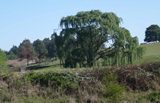Weaver news
|
Schultz A, Underhill LG, Earlé R, Underhill G 2011. Seasonality, distribution and taxonomic status of avian haemosporidian parasites within the Greater Cape Town area, South Africa. Ostrich 82:141-154. ABSTRACT: A total of 9304 birds representing 29 families, 55 genera and 78 species were captured at 10 sites within the Greater Cape Town area. Forty-one avian haemosporidian parasites from three genera were present in 20 avian families, with 1978 (21.2%) individuals infected with one or more parasite species. Leucocytozoon spp. (12.6% of infected birds) exhibited the highest infection rate, followed by Haemoproteus spp. (9.6%) and Plasmodium spp. (0.6%). Prevalence of infection varied from 4.5% at Patryskraal to 28.0% at Tygerberg Nature Reserve. Columbidae had the highest infection rate by Haemoproteus spp. Ploceidae and Sylviidae were infected by all three haemosporidian genera, with Ploceidae the most heavily infected, with six species of avian haemosporidia. All study sites had similar seasonal patterns with two peaks. The first peak coincided with the end of the rainy season in August or September, and the second during January and February, when population sizes peaked on account of seasonal breeding and the presence of large numbers of immature birds susceptible to infection. The prevalence of infections had two seasonal lows, without a complete winter interruption, with the first low occurring in late autumn/early winter. The second low, known as "spring relapse", resulted from acute primary parasitaemia, which follows a peak in haemosporidian infection. Seasonal prevalence patterns as recorded throughout the year in this study are typical of medium latitudes with mild climates and warm seasons. Avian haemosporidian parasites are classified according to the avian families or subfamilies that they infect; this is also taken as the maximum level of specificity for the practice of avian haemosporidian taxonomy. Description of a new species is based upon morphology of gametocyte development in the peripheral blood of the avian host. This does not distinguish between morphologically identical gametocytes from different avian host families, nor is species or family level a valid taxonomic character. Thus, Haemoproteus and Leucocytozoon spp. encountered in this study are considered to be relegated to synonymy with previously described, morphologically similar valid species in avian hosts of other families following the taxonomic path of Valkiunas, thereby eliminating duplication of species. The weavers analysed were (with % birds infected with blood parasites): Cape Weaver (24.4%), Southern Masked Weaver (6.0%), Southern Red Bishop (25.7%), and Yellow Bishop (35.3%). Copies of the pdf are available for Les Underhill Literature as featured in Weaver Watch news items |











